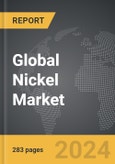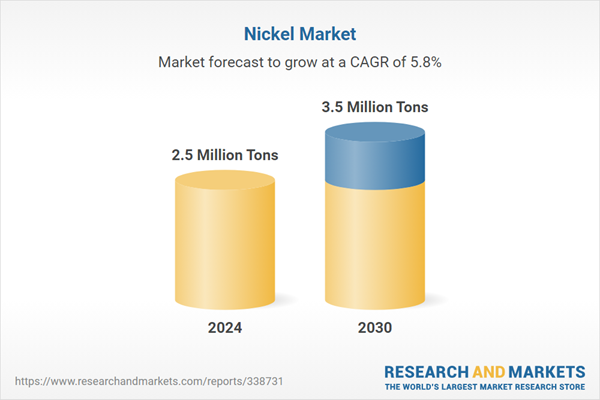The global market for Nickel was sized at 2.5 Million Tons in 2024 and is projected to reach 3.5 Million Tons by 2030, growing at a CAGR of 5.8% from 2024 to 2030. This comprehensive report provides an in-depth analysis of market trends, drivers, and forecasts, helping you make informed business decisions. The report includes the most recent global tariff developments and how they impact the Nickel market.
The long-term outlook for nickel is bolstered by its critical role in the clean energy transition, particularly in EVs and renewable energy systems. Nickel is a key component of lithium-ion batteries, which power most electric vehicles. The demand for these batteries is on rise as the automotive industry shifts away from internal combustion engines towards more sustainable electric alternatives. This transition is driven by global environmental concerns and government policies aimed at reducing carbon emissions, which encourage the adoption of EVs and consequently boost the demand for nickel. Another significant trend impacting the nickel market is the diversification of supply chains. Historically, nickel mining and production have been concentrated in a few countries, but recent geopolitical tensions and trade uncertainties have prompted a push towards securing more stable and sustainable sources. This has led to increased investments in nickel mining projects outside traditional supply areas, particularly in Indonesia, which has recently seen substantial growth in its nickel processing capacity. Moreover, recycling efforts are also becoming a more prominent part of the supply chain, as industries seek to reduce environmental impact and increase the cost-effectiveness of nickel by recovering it from scrap materials.
In addition to EVs and supply chain diversification, nickel is also gaining traction in the energy storage sector. As the world increasingly turns to renewable energy sources, the demand for energy storage solutions that can efficiently store and release energy is essential. Nickel plays a crucial role in several types of advanced battery technologies that are being developed to enhance grid storage and renewable energy integration. The growth of this sector is likely to provide ongoing support for nickel demand, reinforcing its essential status in the modern technology and energy landscape. This continued expansion in nickel use showcases its critical role not only in current industrial applications but also in the future of energy and transportation.
Segments: End-Use (Stainless Steel, Other Alloy Steel, Cast Irons, Alloys & Castings, Electroplating, Other End-Uses).
Geographic Regions/Countries: World; United States; Canada; Japan; China; Europe (France; Germany; Italy; United Kingdom; Spain; Russia; and Rest of Europe); Asia-Pacific (Australia; India; South Korea; and Rest of Asia-Pacific); Latin America (Argentina; Brazil; Mexico; and Rest of Latin America); Middle East (Iran; Israel; Saudi Arabia; United Arab Emirates; and Rest of Middle East); and Africa.
The analysts continuously track trade developments worldwide, drawing insights from leading global economists and over 200 industry and policy institutions, including think tanks, trade organizations, and national economic advisory bodies. This intelligence is integrated into forecasting models to provide timely, data-driven analysis of emerging risks and opportunities.
Global Nickel Market - Key Trends and Drivers Summarized
Nickel is a silvery-white lustrous metal with a slight golden tinge that belongs to the transition metals and is hard and ductile. Known for its excellent conductivity of heat and electricity, nickel is ferromagnetic, bivalent, and harder than iron. One of its most notable properties is its remarkable resistance to corrosion at high temperatures, making it a preferred material in a range of applications. From its traditional use in coinage to more critical roles in creating various alloys, nickel's alloying ability with metals like iron, chromium, and molybdenum enhances its resistance to corrosion and maintains strength at high temperatures, which is essential for industrial applications such as in power plants and engines. It is primarily used in the creation of stainless steel due to its corrosion resistance, good mechanical strength, and toughness over a wide temperature range. Other significant uses include in alloys such as nickel brasses and bronzes, plating, and batteries, particularly in the fast-growing area of rechargeable battery systems including those used in electric vehicles (EVs).The long-term outlook for nickel is bolstered by its critical role in the clean energy transition, particularly in EVs and renewable energy systems. Nickel is a key component of lithium-ion batteries, which power most electric vehicles. The demand for these batteries is on rise as the automotive industry shifts away from internal combustion engines towards more sustainable electric alternatives. This transition is driven by global environmental concerns and government policies aimed at reducing carbon emissions, which encourage the adoption of EVs and consequently boost the demand for nickel. Another significant trend impacting the nickel market is the diversification of supply chains. Historically, nickel mining and production have been concentrated in a few countries, but recent geopolitical tensions and trade uncertainties have prompted a push towards securing more stable and sustainable sources. This has led to increased investments in nickel mining projects outside traditional supply areas, particularly in Indonesia, which has recently seen substantial growth in its nickel processing capacity. Moreover, recycling efforts are also becoming a more prominent part of the supply chain, as industries seek to reduce environmental impact and increase the cost-effectiveness of nickel by recovering it from scrap materials.
In addition to EVs and supply chain diversification, nickel is also gaining traction in the energy storage sector. As the world increasingly turns to renewable energy sources, the demand for energy storage solutions that can efficiently store and release energy is essential. Nickel plays a crucial role in several types of advanced battery technologies that are being developed to enhance grid storage and renewable energy integration. The growth of this sector is likely to provide ongoing support for nickel demand, reinforcing its essential status in the modern technology and energy landscape. This continued expansion in nickel use showcases its critical role not only in current industrial applications but also in the future of energy and transportation.
Report Scope
The report analyzes the Nickel market, presented in terms of units. The analysis covers the key segments and geographic regions outlined below.Segments: End-Use (Stainless Steel, Other Alloy Steel, Cast Irons, Alloys & Castings, Electroplating, Other End-Uses).
Geographic Regions/Countries: World; United States; Canada; Japan; China; Europe (France; Germany; Italy; United Kingdom; Spain; Russia; and Rest of Europe); Asia-Pacific (Australia; India; South Korea; and Rest of Asia-Pacific); Latin America (Argentina; Brazil; Mexico; and Rest of Latin America); Middle East (Iran; Israel; Saudi Arabia; United Arab Emirates; and Rest of Middle East); and Africa.
Key Insights:
- Market Growth: Understand the significant growth trajectory of the Stainless Steel segment, which is expected to reach 2.5 Million Tons by 2030 with a CAGR of a 6.3%. The Other Alloy Steel segment is also set to grow at 3.8% CAGR over the analysis period.
- Regional Analysis: Gain insights into the U.S. market, sized at 645.8 Thousand Tons in 2024, and China, forecasted to grow at an impressive 9.0% CAGR to reach 802.4 Thousand Tons by 2030. Discover growth trends in other key regions, including Japan, Canada, Germany, and the Asia-Pacific.
Why You Should Buy This Report:
- Detailed Market Analysis: Access a thorough analysis of the Global Nickel Market, covering all major geographic regions and market segments.
- Competitive Insights: Get an overview of the competitive landscape, including the market presence of major players across different geographies.
- Future Trends and Drivers: Understand the key trends and drivers shaping the future of the Global Nickel Market.
- Actionable Insights: Benefit from actionable insights that can help you identify new revenue opportunities and make strategic business decisions.
Key Questions Answered:
- How is the Global Nickel Market expected to evolve by 2030?
- What are the main drivers and restraints affecting the market?
- Which market segments will grow the most over the forecast period?
- How will market shares for different regions and segments change by 2030?
- Who are the leading players in the market, and what are their prospects?
Report Features:
- Comprehensive Market Data: Independent analysis of annual sales and market forecasts in US$ Million from 2024 to 2030.
- In-Depth Regional Analysis: Detailed insights into key markets, including the U.S., China, Japan, Canada, Europe, Asia-Pacific, Latin America, Middle East, and Africa.
- Company Profiles: Coverage of players such as Baosteel Group Corporation, Belmont Metals, Inc., Eramet Group, H.C. Starck GmbH, Outokumpu Oyj and more.
- Complimentary Updates: Receive free report updates for one year to keep you informed of the latest market developments.
Some of the 184 companies featured in this Nickel market report include:
- Baosteel Group Corporation
- Belmont Metals, Inc.
- Eramet Group
- H.C. Starck GmbH
- Outokumpu Oyj
- RUSAL
Tariff Impact Analysis: Key Insights for 2025
Global tariff negotiations across 180+ countries are reshaping supply chains, costs, and competitiveness. This report reflects the latest developments as of April 2025 and incorporates forward-looking insights into the market outlook.The analysts continuously track trade developments worldwide, drawing insights from leading global economists and over 200 industry and policy institutions, including think tanks, trade organizations, and national economic advisory bodies. This intelligence is integrated into forecasting models to provide timely, data-driven analysis of emerging risks and opportunities.
What’s Included in This Edition:
- Tariff-adjusted market forecasts by region and segment
- Analysis of cost and supply chain implications by sourcing and trade exposure
- Strategic insights into geographic shifts
Buyers receive a free July 2025 update with:
- Finalized tariff impacts and new trade agreement effects
- Updated projections reflecting global sourcing and cost shifts
- Expanded country-specific coverage across the industry
Table of Contents
I. METHODOLOGYII. EXECUTIVE SUMMARY2. FOCUS ON SELECT PLAYERSIII. MARKET ANALYSISSOUTH KOREAREST OF ASIA-PACIFICARGENTINABRAZILMEXICOREST OF LATIN AMERICAIRANISRAELSAUDI ARABIAUNITED ARAB EMIRATESREST OF MIDDLE EASTIV. COMPETITION
1. MARKET OVERVIEW
3. MARKET TRENDS & DRIVERS
4. GLOBAL MARKET PERSPECTIVE
UNITED STATES
CANADA
JAPAN
CHINA
EUROPE
FRANCE
GERMANY
ITALY
UNITED KINGDOM
SPAIN
RUSSIA
REST OF EUROPE
ASIA-PACIFIC
AUSTRALIA
INDIA
LATIN AMERICA
MIDDLE EAST
AFRICA
Companies Mentioned (Partial List)
A selection of companies mentioned in this report includes, but is not limited to:
- Baosteel Group Corporation
- Belmont Metals, Inc.
- Eramet Group
- H.C. Starck GmbH
- Outokumpu Oyj
- RUSAL
Table Information
| Report Attribute | Details |
|---|---|
| No. of Pages | 283 |
| Published | April 2025 |
| Forecast Period | 2024 - 2030 |
| Estimated Market Value in 2024 | 2.5 Million Tons |
| Forecasted Market Value by 2030 | 3.5 Million Tons |
| Compound Annual Growth Rate | 5.8% |
| Regions Covered | Global |









